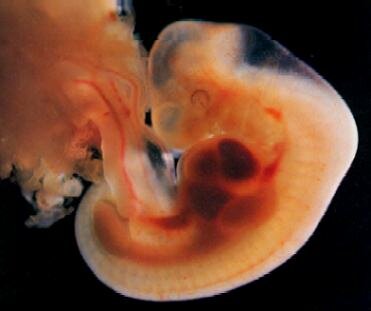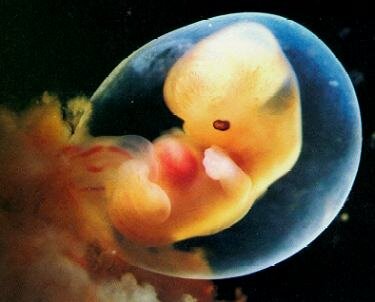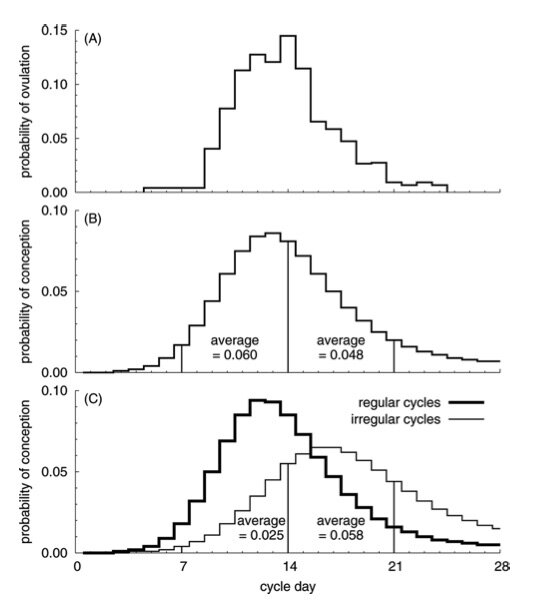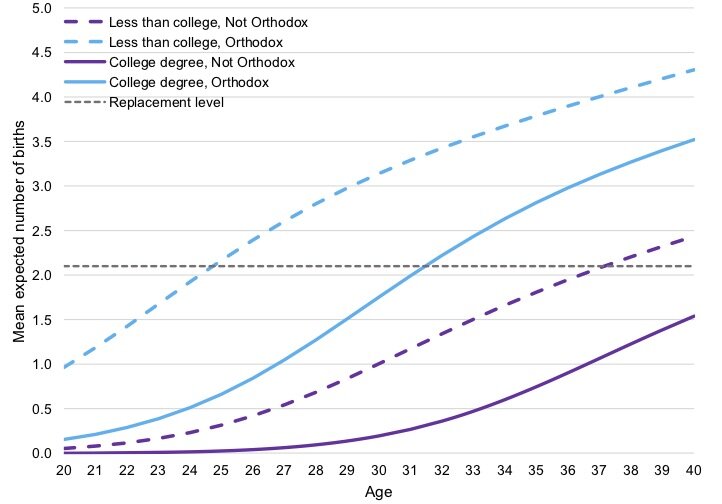Let’s go back to some of the Talmud we studied last week in the daf yomi one-page-a-day cycle, and catch up with some topics we didn’t have a chance to cover.
Which fetus grows quicker, Male or Female? (The male)
In the Mishnah (30a) there is a dispute between Rabbi Yishmael and the rabbis about the length of time it takes for a fetus to reach a milestone of completion.
רבי ישמעאל אומר יום מ"א תשב לזכר ולנדה יום פ"א תשב לזכר ולנקבה ולנדה שהזכר נגמר למ"א והנקבה לפ"א וחכ"א אחד בריית הזכר ואחד בריית הנקבה זה וזה מ"א
Rabbi Yishmael said…the formation of the male offspring concludes on the forty-first day and the formation of the female offspring concludes on the eighty-first day. And the Rabbis say: both a male and female fetus concludes on the forty-first day.
In one respect, both the rabbis and Rabbi Yishmael were incorrect: the fetus is not fully formed, or fully anything by the forty (ot the forty-first day). Here is what a human embryo looks like at about four weeks (28 days), six weeks (42 days) and seven weeks (49 days). Does one stage look any more “complete” than another?
Human embryo at about 28 days.
Human embryo at about 40 days. It is about 11mm long.
Human embryo at about 46 days. All images are from From Nilsson, Lennart. A Child is Born. Delacorte Press/Seymour Lawrence. 1990.
But in another respect Rabbi Yishmael was certainly correct and the rabbis were wrong: the male and female fetus do grow at different rates. Back in the late 1960s scientists suggested that the greater the antigenic differences between mother and fetus, the greater is the fetal growth rate. In other words an (XY) male fetus grows at a quicker rate than a (XX) female fetus because an XY fetus is more different from its XX mother than is an XX fetus.
It is well known that, on average, boys weigh slightly more than girls at birth. Less known is the fact that when in utero, boys grow at a quicker rate than girls. For example the diameter of the fetal head (called the biparietal diameter) is larger in male fetuses than in the female, and this difference becomes statistically significant at 24 weeks. Head circumference is also larger for males and becomes significantly greater than that of the female fetus at 24 weeks' gestation.
Head circumference (centimeters) as a function of gestational length (weeks) in both male (•) and female (o) fetuses. From Parker A et al. The ultrasound estimation of sex-related variations of intrauterine growth. Am. J. Obstet. Gynecol 1984. 149:665-669.
To conclude: the evidence supports Rabbi Yishmael to the degree that later in utero boys do grow at a slightly quicker rate. However, there is no difference between growth rates before about 24 weeks, and certainly at a forty day cut-off both male and female fetuses are identical. With a generous reading, that supports the opinion of the rabbis.
Very much related to this topic is the story told on the same page of Talmud about Cleopatra and her cruel experiments on young women.
נדה ל, ב
אמרו לו לר' ישמעאל מעשה בקליאופטרא מלכת אלכסנדרוס שנתחייבו שפחותיה הריגה למלכות ובדקן ומצאן זה וזה למ"א אמר להן אני מביא לכם ראייה מן התורה ואתם מביאין לי ראייה מן השוטים
They said to Rabbi Yishmael: There was an incident involving Cleopatra, Queen of Alexandria. Since her maidservants were sentenced to death by the government, she took advantage of the opportunity and experimented on them to determine the amount of time it takes for an embryo to develop. She had her maidservants engage in intercourse and operated on them following their execution in order to determine the stage at which an embryo is fully formed, and found that both in this case, when the embryo is male, and that case, when it is female, the formation is complete on the forty-first day after conception. Rabbi Yishmael said to them in response: I bring you proof from the Torah, and you bring me proof from the fools?
Not really. A forty day male and a forty female embryo are visually indistinguishable. The reproductive tract begins to develop in the sixth week of the embryonic period, and external genitalia develop during the 8th-14th weeks of gestation. However, external determination of sex is not possible before urogenital modeling is complete, which also occurs between the 8th and 14th weeks. In the hands of an expert ultrasound operator, sonographic determination of fetal sex has been reported as early as 11 weeks’ menstrual age, “but it may be obtained reliably only as early as 12 to 13 weeks.” (The challenge is distinguishing “between a small penis and a prominent clitoris and between minimally edematous labia and a small scrotum filled with spongy connective tissue.” Now you know.)
In the course of a series of challenges to the opinion of Rabbi Yishmael, the Talmud cites the forth century sage Abaye. He suggests that by examining certain of their anatomical characteristics we can determine if two fetuses were a similar age (“אמר אביי בסימניהון שוין”). He does not define those “characteristics” but Rashi, the eleventh century commentator does.
בסימניהון שוין - נקבה שנמצא ליום פ"א לא היו אבריה ושערה וצפורניה אלא כשיעור של זכר ליום מ"א
Identical characteristics: The limbs, hair, and nails of an 81 day-old female fetus are as developed as those of a 41 day-old male fetus.
There is a problem here. Fingernails only begin to start to develop around day 70 and toenails around day 100. Neither are present at day 40. Hair develops between weeks 7-12. So the claim that either was clearly present in a 40 or 80 day embryo is not possible.
2. How does the uterus grow?(It stretches)
נדה לא, א
תנו רבנן שלשה חדשים הראשונים ולד דר במדור התחתון אמצעיים ולד דר במדור האמצעי אחרונים ולד דר במדור העליון וכיון שהגיע זמנו לצאת מתהפך ויוצא וזהו חבלי אשה
The Sages taught in a baraita: During the first three months of pregnancy, the fetus resides in the lower compartment of the womb; in the middle three months, the fetus resides in the middle compartment; and during the last three months of pregnancy the fetus resides in the upper compartment. And once its time to emerge arrives, it turns upside down and emerges; and this is what causes labor pains…
Here is what actually happens. The fetus does not occupy different parts of the uterus as it grow. Instead, the uterus itself expands to accommodate the fetus. In a woman who has never been pregnant, the uterus is about 7-8cm long, around the size of a fist. It grows as the fetus develops, reaching up into the abdominal cavity. At 24 weeks’ gestation, the top of the uterus is at the approximate height of the umbilicus, and by the end of pregnancy it may be felt a little below the lower end of the breast bone.
In contrast, the Talmudic description of the baby turning is correct. The baby floats in a heads-up position until the very last couple of weeks of the pregnancy, when it does a 180 degree flip. About 4% of babies refuse to undertake these gymnastics, and remain heads-up, in what is called a breech presentation.
3. who causes worse labor pains, boys or girls?(They are equal OFFENDERS)
נדה לא, א
היינו דתנן חבלי של נקבה מרובין משל זכר
The labor pains experienced by a woman who gives birth to a female are greater than those experienced by a woman who gives birth to a male…
…מאי שנא חבלי נקבה מרובין משל זכר זה בא כדרך תשמישו וזה בא כדרך תשמישו זו הופכת פניה וזה אין הופך פניו
…The Gemara asks: What is different about the labor pains experienced by a woman who gives birth to a female, that they are greater than those experienced by a woman who gives birth to a male?The Gemara answers: This one, a male fetus, emerges in the manner in which it engages in intercourse. Just as a male engages in intercourse facing downward, so too, it is born while facing down. And that one, a female fetus, emerges in the manner in which it engages in intercourse,i.e., facing upward. Consequently, that one, a female fetus, turns its face around before it is born, but this one, a male fetus, does not turn its face around before it is born.
It wasn’t just the rabbis of the Talmud who believed girls caused their mothers more pain during childbirth. Here is Aristotle (d. 322 BCE), in his Historia Animalum (Book 7 Chapter 4):
As a general rule women who are pregnant of a male child escape comparatively easily and retain a comparatively healthy look, but it is otherwise with those whose infant is female; for these latter look as a rule paler and suffer more pain…nevertheless the rule is subject to exceptions.
LEFT: Face down (OA) presentation. Right: Face up (OP) presentation. From here.
When a baby is born face down, that is to day facing the mother’s back, it is said to be in the occipital anterior (OA) position. This is the most common presentation. When the baby is born face up, that is to say facing the mother’s front, it is said to be in the occipital posterior (OP) position. That presentation is less common. In 2005 a group from the Departments of Obstetrics and Gynecology at the Brigham and Women’s Hospital and Boston Medical Center conducted a prospective cohort study of 1,562 women to evaluate changes in baby’s position during labor. They reported that 80% of the babies were delivered OA, 8% were OP and 12% were in the in-between transverse position. Now what about the Talmud’s suggestion that girls are not born face down, or as an obstetrician would say, in the OA position, but rather face up? Take a look for yourself at the results of the study:
Demographic and Pregnancy Characteristics of 1,572 births. From Lieberman E. Davidson K, Lee-Parritz A. Shearer E. Changes in Fetal Position During Labor and Their Association With Epidural Analgesia. Obstetrics & Gynecology 2005. 105 (1): 974-982.
As you can see, boys made up 58% of the face down births and only 49% of the face up births. So although the Talmud’s suggestion that all boys are born face down is not correct, it is certainly the case that slightly more boys than girls are born in this presentation, at least according to this study. However a 2017 Israeli study (which looked at babies with large heads) found that boys made up 51% of the face down births, and 49% of the face up births, which was a statistical wash.
What about pain? If the Talmud is correct, then the face-up (supposedly female) presentation should be more painful than the face-down (supposedly male) one. Is it? Well, no. The Boston study found that mothers face up baby at delivery did not report more painful labors. They had a mean pain score of 4.9 out of 10, compared with 5.2 for other positions - a non statistical difference.
4. Is intercourse during pregnancy harmful?(No)
נדה לא, א
תנו רבנן שלשה חדשים הראשונים תשמיש קשה לאשה וגם קשה לולד אמצעיים קשה לאשה ויפה לולד אחרונים יפה לאשה ויפה לולד שמתוך כך נמצא הולד מלובן ומזורז
The Sages taught in a baraita: During the first three months of pregnancy, sexual intercourse is difficult and harmful for the woman and is also difficult for the offspring. During the middle three months, intercourse is difficult for the woman but is beneficial for the offspring. During the last three months, sexual intercourse is beneficial for the woman and beneficial for the offspring; as a result of it the offspring is found to be strong and fair skinned.
תנא המשמש מטתו ליום תשעים כאילו שופך דמים מנא ידע אלא אמר אביי משמש והולך (תהלים קטז, ו) ושומר פתאים ה'
The Sages taught in a baraita: With regard to one who engages in intercourse with his wife on the ninetieth day of her pregnancy, it is as though he spills her blood.The Gemara asks: How does one know that it is the ninetieth day of her pregnancy? Rather, Abaye says: One should go ahead and engage in intercourse with his wife even if it might be the ninetieth day, and rely on God to prevent any ensuing harm, as the verse states: “The Lord preserves the simple” (Psalms 116:6).
Contrary to the Talmud’s assertion, there is no association with the frequency of intercourse during pregnancy and the danger of a miscarriage. Here is what the Mayo Clinic tells patients:
Your developing baby is protected by the amniotic fluid in your uterus, as well as by the strong muscles of the uterus itself. Sexual activity won't affect your baby, as long as you don't have complications such as preterm labor or placenta problems…
Having sex during pregnancy won't provoke a miscarriage. Most miscarriages occur because the fetus isn't developing normally.
“יש ניהגיס כשנכנסה אשתו בחדש ט׳ לעיבורה לעשות בחדש ההוא מצות פתיחת ההיכל והוא מנהג יפה
There is a custom during the ninth month a woman’s pregnancy to give her husband the mitzvah of opening the ark. And this is a good custom”
You may have heard about a Jewish folk remedy (a segulah) believed to help start the process of labor in a woman ready to give birth. It is to give her husband the honor of opening the ark during the service in the synagogue. I am not aware of any randomized clinical trial of the belief, but there have been randomized trials of another claim, this one perhaps a little more widespread. That claim is that intercourse late in pregnancy will induce labor.
It goes way back to Aristotle in the fourth century BCE, who wrote that “women who have a connection with their husbands shortly before childbirth are delivered all the more quickly.” However Soranus, another Greek physician who lived in the third century CE (and about 500 years after Aristotle) believed that any intercourse during pregnancy was harmful. Here is what he wrote in his textbook of gynecology:
Sexual intercourse however is always harmful to pregnant women both on account of the tossing motion and because the uterus is forced to submit to a movement which is contrary to the progress of pregnancy. And even more so in the last months lest because of it the chorion burst and the fluid which has been prepared for use in parturition be evacuated before the proper time.
“It is important to find a scientific answer to this issue” wrote a team of researchers in Portugal, “because if it is proven to be true, a decrease in the number of medical interventions for post-term pregnancy can occur.” So they randomized pregnant women to two groups: “vaginal intercourse at least twice a week or abstinence.” Yes, you read that correctly. 63 women and their lucky partners were assigned to the intervention group and 60 to the control. And there were no significant differences between the rates of spontaneous onset of labor in the two groups. A 2019 review from the School of Medicine in Naples Italy concluded that “in women with singleton [i.e. not twins], cephalic [head down], low-risk pregnancies, sexual intercourse at term does not significantly increase the incidence of spontaneous onset of labor.” So that myth is now officially busted.
















